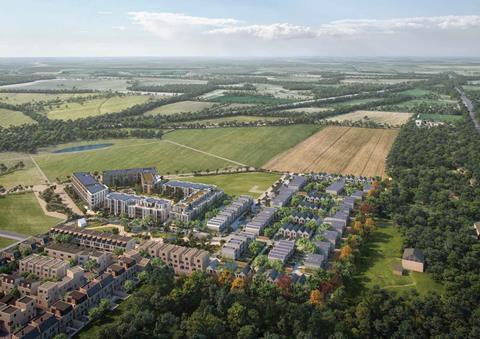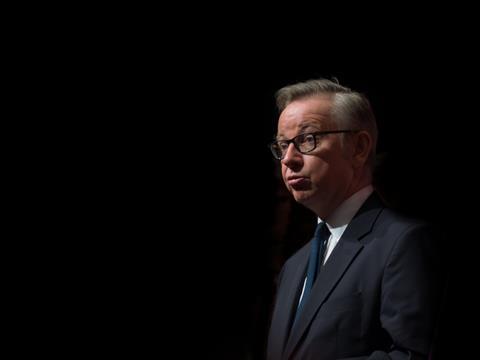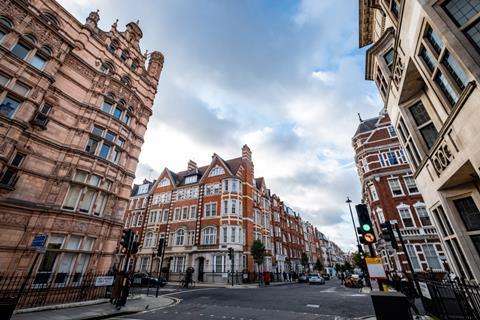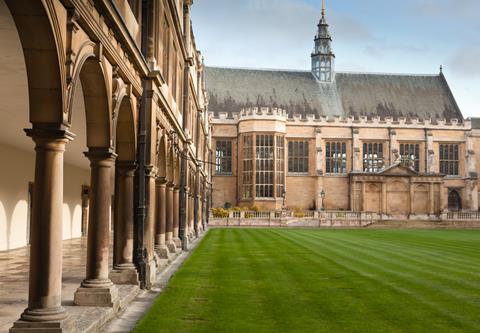The secretary of state wants to build nearly three times as many homes as the ‘ambitious’ housing target set by Cambridge’s own planners. Is there something he knows that they don’t? Daniel Gayne reports

Budget day came and went with little to trouble or please the built environment. A smattering of funds for redevelopment projects here and there, a few tax cuts for businesses – but no rabbits, no hats.
While the chancellor Jeremy Hunt produced little to shout about, however, over at the Department for Levelling Up, Housing and Communities, Michael Gove was ploughing ahead with his latest grand project. The housing secretary used the fiscal event as an opportunity to quietly publish his 38-page vision for a radical transformation of one of the UK’s most historic cities.
Gove first announced his intentions in a major housing speech last July, but the Case for Cambridge sets out his plans for the city for the first time in some detail.
The task he has set himself is not a small one – particularly for a politician whose time in office may be quickly running out. A new urban quarter of more than 150,000 homes built in less than thirty years against the advice of the local council, the ardent opposition of the region’s rural Tory MP and in the face of severe environmental limitations. Can he possibly do it?
One city, two plans
“The thing you have to remember with Michael is that he is a bit of a Maoist.” David Cameron’s famous appraisal of his then-education secretary was not a comment on his ideology, but his belief that “the world makes progress through a process of creative destruction”.
Education unions, housebuilders and remainers can all attest to this fact. Wherever he has found himself in Whitehall, Gove has always been a man with a vision, relentlessly pursued.
His first opponent in this battle will most likely be the sceptical local authority.

There is no doubt that the region’s planners think Cambridge is ripe for expansion. According to Stephen Kelly, chief planner at the Greater Cambridge Shared Planning Authority, the secretary of state’s initial announcement last July was “slightly surprising”. Not only because neither Cambridge City Council nor South Cambridgeshire District Council, which have a combined planning service covering the city region, were invited to or forewarned of the speech, but also because the combined planning authority already had its own “enormous housing and growth programme” being driven forward by a staff of 130.
There are 20,000 homes already slated to be built in the current local plan, across developments such as Northstowe, Waterbeach, Cambourne, Bourne Airfield, Wellcome Genome Campus and Eddington. Sufficient space has been identified in an emerging plan, which runs to 2041, for around 84,000 additional jobs and 61,000 houses.
“For two district councils, that is a pretty astonishing amount of growth,” says Kelly.
But while his vision document congratulated the local authority on its “ambition” and “strong record on delivery”, Gove nonetheless appears to be underwhelmed.
The Case for Cambridge praises the city for its achievement in building Europe’s largest technology cluster, home to more than 5,000 high-tech firms, but compared it unfavourably to faster-growing rivals such as Boston in the USA, which has six times the number of life science jobs.
Fixing this problem, in Gove’s eyes, will require a more significant push to increase housing and commercial development in Cambridge than the one envisioned by the region’s planners. The key difference in viewpoint appears to be their reverence for Cambridge’s green belt.
Since the 1950s, the expansion of Cambridge city centre has been intentionally limited, with development focusing on what have become known as the “necklace villages” that surround it. While Gove’s planning policy has sought to protect the green belt elsewhere, he has indicated that an exception could be made to help augment Cambridge’s growth.

It is somewhere in this area – no decisions have yet been taken on a location – that the housing secretary wants to build “a major new quarter”. Homes England chair Peter Freeman has been given £5m and tasked with scoping out plans for a new neighbourhood complete with affordable homes, a sustainable transport network and a substantial new green space to rival the Royal Parks.
“The government is committed to deploying gentle density as a core tenet of the city’s physical growth,” according to the vision document, which highlights Clifton in Bristol and Marylebone in London, as well as the European cities of Utrecht and Toulouse, as models.
The new Office for Place will help to shape the design of the new development, along with local experts. The report says “a range of tools” might be used, including design codes, pattern books, visual preference surveys, local design review panels, development orders and thoughtful masterplanning.
It also notes that there is “huge potential to capture, for the public benefit, any increase in land value that will arise from development decisions taken in Cambridge by central and local government”.
But if Gove’s description of the new Cambridge sounds fairly heavenly, a few words from Kelly might bring you back to the ground.
“It sometimes feels like people are operating in something of a conceptual vacuum and that these are just numbers, but if you understand that the City of Cambridge has 53,000 houses, then the idea of building five more Cambridges in 20 years begins to look somewhat challenging,” he says, noting that it took 50 years to build only slightly more than 100,000 homes in Milton Keynes.
Kelly adds that there is a fundamental question over whether the market could even absorb the level of housebuilding that Gove envisions. “The fundamental process of building houses these days is about managing margin,” he says.
“The very last thing that the housebuilders are going to do is build houses where they are not convinced they will have people to buy them. [So] there are some real challenges in whether the market is actually even capable of stepping up were you to provide land allocated for that purpose.”
Gove appears to have come to the same conclusion, at least to some degree. Last summer, the talk was of a vision for Cambridge in 2040, but in the latest documents, the housing secretary appears to have given himself an extra decade, with the target now set at 2050.
The secretary of state will also have to deal with opposition from rural stakeholders within his own party. Anthony Browne, Conservative MP for South Cambridgeshire, did not even wait for Gove’s speech to begin last summer before calling the plans “nonsense”.
Besides the scale of building, the main difference between the local plan and Gove’s vision is the latter’s desire for a dense urban development. While existing plans are mainly for housing developments on the city’s fringes, Gove spoke in his pre-Christmas speech of his plan for an urban quarter “truly plugged into the existing city rather than simply orbiting it”.
Such development would likely mean riding roughshod over green belt land on the edge of town, putting the housing secretary on a collision course with fellow partisans in the region.
Dry town
And then there is the biggest obstacle: water. Cambridge and the wider East Anglia area is the driest part of the UK, so there is less rainfall to replenish water supply, a fact that has only been exacerbated by climate change and the increased levels of paving driven by urbanisation, which slows the natural capture of rainwater.
Supply for the city region is managed by a very small water company called Cambridge Water, which does not own any reservoirs and provides water by sucking it up from the ground – a method called abstraction – which, if overused, can cause aquifer levels to fall and rivers to dry up.
Cambridgeshire’s chalk aquifers are not only the main source of water for residents and businesses locally. They also supply globally-unique chalk streams such as Cherry Hinton Brook, Hobson’s Brook, the River Cam and River Granta, which support a range of diverse wildlife.
“Ofwat has not typically been supportive of any new major water resources over the past decade or so,” explains Jo Parker, chair of the Institution of Civil Engineers’ Water and Sanitation Community Advisory Board. “In fact, to preserve environmentally sensitive areas, water utility companies have been trying to reduce the amount of water they draw from chalk layers, which make up much of the landscape in East Anglia.”
Our water scarcity issue makes it slightly indulgent to try and meet the country’s housing need in a place that doesn’t have any water
Stephen Kelly, chief planner, Greater Cambridge Shared Planning
Water supply issues are already holding back housing development around the city. In its previous draft water resources management plan, Cambridge Water failed to demonstrate that there was enough to supply all of the new properties in the emerging local plan without risk of deterioration.
The Environment Agency recently confirmed that it had formally objected to five large housing developments in the south of the county because of fears they could not sustainably supply water. It has warned that planning permission for more than 10,000 homes in the Greater Cambridge area and 300,000 square metres of research space at Cambridge University are in jeopardy if solutions cannot be found.
A document published alongside the Case for Cambridge outlines the government’s plan for a two-pronged approach to solving the water scarcity issue, to be led by Dr Paul Leinster, former chief of the Environment Agency, who will chair the Water Scarcity Group.
In the long term, supply will be increased, initially through two new pieces of infrastructure: a new reservoir in the Fens will delivery 43.5 megalitres per day, while a new pipeline will transfer 26 megalitres per day from Grafham Water, currently used by Affinity Water.
But, according to Kelly, a new reservoir would only solve supply requirements for the existing local plan and is “not sufficient if you start to go beyond that” – a point that is conceded in the water scarcity document.
“Our ambition to drive forward growth and investment to the city will require additional water supply to that currently planned,” it said. “We are commissioning regional-scale models to support a long-term water resources plan that meets our development growth ambitions.
“This will include working with water companies across the region to identify new transfers and supply-side options beyond those already in Water Resources East’s core regional plan.”
The problem will be compounded by the fact that the Environment Agency is expected to begin capping abstraction licenses in two steps in 2030 and 2040. “So, at the same time as you’re getting some new supply, you are also finding that your ability to draw water from the ground is going to be reduced,” says Kelly.
What is more, the process of consenting and getting approval for investment and then building it means that the water transfer would not be available until 2032 and the reservoir not available until 2036 at the earliest. “So, what do you do between now and then if you are going to accelerate delivery?” asks Kelly.

In the meantime, the DLUHC has outlined a broad-based programme to increase efficiency and thereby reduce water demand. This will be centred on a £4.5m investment to retrofit water efficient devices – including efficient showerheads, tap aerators and boundary flow restrictors – into existing buildings, which is intended to prime a water credit system, to be launched later this year.
Initial retrofits across Greater Cambridge will be targeted at commercial premises and social housing stock, and the government will be working with specialist retrofit companies to offer water audits and retrofit to households and businesses across the region.
Under the water credits system, developers can offset their development through the purchase and sale of water credits. The hope is that this system will provide further funding for retrofit after the initial government investment period.
According to the government, efficiency measures at Cambridge schools alone could deliver water savings equivalent to that used by more than 2,000 new homes.
The water scarcity document also said that it expected Cambridge Water to roll out “an ambitious programme of smart meter installation” and promised £1.45m investment in agriculture to “position Cambridge as a trailblazer area for the government’s national approach to water management in the agricultural industry”.
Another £1m will be invested in nature-based solutions, which will enhance long-term flow of water bodies and improve resilience to floods and improve biodiversity. This will ensure that up to 8.1 megalitres of water per day that would otherwise flow out to see is captured for public use.
Parker is enthusiastic about the adoption of sustainable urban drainage systems, a type of nature-based solution. “It would be good to see SuDs and retrofitting drainage solutions in built-up areas promoted more actively as these solutions help improve infiltration and increase the amount of water captured,” she says.
“More stringent building regulations to promote water efficiency could be part of the solution. A scheme to give water efficiency ratings similar to energy efficiency ratings could also make a difference, as would universal smart metering and white goods labelling.”
While the government’s multifaceted approach to lowering demand is bound to have some success, it is so far unclear how much housebuilding capacity it expects to be freed up, and on what timescale.
On the topic of water, Kelly takes a more conciliatory tone when speaking about his Whitehall peers. “We recognise we need government help on some of these issues,” he says. “We are not hostile to it, [but] where I think we differ is whether we need a development corporation for it”.
A different mindset
For many involved in development in the region, the major response to Gove’s announcement has been a certain degree of bafflement. Kelly says he wants to know which problem is the priority for the government in Cambridge: growing the economy or solving the housing crisis.
If it is the latter, he says, “our water scarcity issue makes that slightly indulgent in a way to try and meet the country’s housing need in a place that doesn’t have any water”.
If the Case for Cambridge is anything to go by, Gove still seems keen to have it both ways. The report cites the city’s affordability ratio of 12.7 (median house price in years of median salary) as being far higher than the English average of 8.4. But relatively more focus is given to the economic analysis.

Illustrative growth scenarios set out in the report claim that, if 150,000 new homes are built by 2050, there is a potential to add between £3.2bn and £9.7bn to the economy, with a central estimate of £6.4bn. A smaller achievement of 100,000 new homes by 2050 could add between £2.1bn and £6.4bn, with a central estimate of £4.3bn, says the government.
According to Zoe Metcalfe, client director at AtkinsRéalis, the Cambridge 2040 Vision may quickly become a case study in how outdated models can lead to development in the wrong areas. By the human-centric standards of the 21st century, Cambridge’s small size and high economic potential make it an excellent candidate for expansion. But today we live in a much more ecologically conscious world – or at least would like to think that we do.
“Growing that London to Cambridge element seems intuitive, but actually we are in a different place now in terms of the climate risk, and trying to solve something by generating an even bigger problem than we already have is counterproductive,” says Metcalfe.
“When we work against nature rather than with nature, we are going to generate significant costs in terms of those interventions around infrastructure. Nature-based solutions are not going to work on their own.”
She suggests that, instead of looking to extend the sprawl of existing high-potential cities, it would be better to develop the transit and communications infrastructure that links towns and cities, so that economic growth can be widely distributed while focusing resource-intensive housing expansion in less environmentally sensitive areas.
“There’s an opportunity to think differently if we could look more across the pan-region of going east to west rather than simply north to south,” she says, alluding to the semi-urbanised corridor that links Cambridge, Milton Keynes and Oxford. A radical new model of urbanism such as this would be “something we can export” as a country, Metcalfe says.
Kelly seems to think that Gove could contribute more by helping to speed up delivery of oven-ready housing and infrastructure schemes. “Let’s focus on speeding stuff up with housing subsidy or what have you and understanding the barriers to speeding things up, rather than going out and finding more sites,” he says.
”There’s an opportunity to think differently if we could look more across the pan-region of going east to west rather than simply north to south”
Zoe Metcalfe, client director, AtkinsRéalis
“We’ve got a 500 million-pound city deal, but it’s not sufficient to provide the connected public transport corridors that we know we need to connect the homes that we have in our plan to the jobs in science and technology and so on.”
The city deal funded a major guided busway to the west of the city, but inflation cut into the fund and now similar public transort corridors to the south and east, costing a few hundred million pounds, are in need of funding. This, Kelly feels, seems to be low-hanging fruit for a government expending a great deal of energy on growing Cambridge.
“Some of the UK’s best assets in terms of economic growth are currently connected by a single carriageway road,” he says, speaking in advance of the Budget. “If your focus is really to create a global supercluster, that’s a fantastic piece of no regrets infrastructure”.
At least part of Kelly’s request appears to have been answered, with £7.2m committed to progress connectivity schemes for the Cambridge Biomedical Campus in the south of the city.
The budget also saw the government commit to the next stage of East West Rail, which will eventually link the city with Oxford, and the vision document alluded to a transport system for the city made up of several elements, “which may range from improved walking and cycling routes to mass transit system options, such as trams and light rail”.
What next?
The man who once said the country was tired of experts is not the kind of politician to give up just because he is told that something is impossible or ill-advised. So perhaps the Cambridge endeavour will go a little like HS2, rumbling on interminably at an ever-diminishing scale.
For now, the project is in the hands of Peter Freeman, who is leading a cross-departmental team of civil servants to determine what kind of development corporation would be most appropriate for the job.
In his own foreword to the Case for Cambridge, Freeman says that “the level of growth proposed by The Case for Cambridge will necessarily require an unprecedented level of funding”, and the document itself promises a multi-year funding settlement to be set out at the new spending review.
>>See also: Cambridge council ‘not consulted’ on plan to build 250,000 homes
Kelly says that Freeman, unlike the secretary of state, has “made a clear effort to engage” with regional politicians and officials, but there is still a lack of clarity on what the delivery group is for and who will be truly driving it. He says: “Our communities need to understand more transparently who it is, what’s its role, who are the decision makers in that space? How do decisions get made and how does the local voice get represented in that?”
He believes that the plan for a development corporation was “a proxy for doing something”, announced to maintain momentum, and he would be “very surprised if there was any vehicle you could come up with that would be capable of delivering that magnitude of additional housing in that time frame”.
Gove’s revolutionary rhetoric can often generate admiration and annoyance simultaneously. When it comes to Cambridge 2040, the housing secretary has set a most ambitious goal. Only time will tell if the plans can be delivered in reality.
















1 Readers' comment